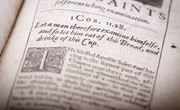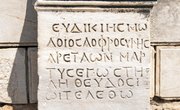The Anglo-Saxon language, also known as Old English, was used between the fifth and twelfth centuries. “Beowulf,” the first English epic, is written in Anglo-Saxon. As a language, Anglo-Saxon is very similar to modern German and Icelandic. Thankfully, there are many available translations of Anglo-Saxon poetry, so there is no need to learn how to read or write the language. To write an Anglo-Saxon style poem, there are poetic conventions -- which may seem foreign to a Modern English poet -- that you can familiarize yourself with.
Reading
The quickest and best way to familiarize yourself with Anglo-Saxon poetry is to read some. Although you can read excerpts from Beowulf, it is more efficient to look at some of the shorter, lesser-known poems. “The Wanderer,” “The Battle of Maldon” and “Caedmon’s Hymn” are excellent examples. You may also want to check out some of Gerard Manley Hopkins’ poetry because he adapted the Anglo-Saxon style into what is termed “sprung rhythm.” A good example of this can be seen in his poem “Pied Beauty” written in 1877.
Themes
There are two common themes in Anglo-Saxon poetry: “contemptus mundi” and “vanitas.” These two themes are related to each other and are both Latin terms. “Vanitas” translates as “life is transitory” -- that is, all worldly things and joys are fleeting. “Contemptus mundi” translates as “scorn for the world.” However, this does not necessarily mean that earthly things should be hated; rather, it is an acknowledgment that material goods and earthly deeds are meaningless without consideration of the eternal soul.
Subjects
Typical subjects in Anglo-Saxon poetry are loyalty to the king, the despair of separation from home and kin, the carnage of warfare and descriptions of Christian visions. However, since some of these subjects may be difficult for you to relate to, feel free to update them to suit a contemporary audience. For example, separation from home and kin can be transferred to address the difficulties of running away from home or, instead of writing about a Christian vision, you could write about a dream you had.
Stress and Alliteration
Typically, English poetry most people are familiar with uses meter and rhyme to organize its structure. For example, here are 2 lines from the poem “In Flanders Fields,” written during WWI by John McCrae: “We are the Dead. Short days ago / We lived, felt dawn, saw sunset glow […]” Although these lines express a similar theme and subject to Anglo-Saxon poetry, the structure is markedly different. Anglo-Saxon poetry does not use rhyme, such as “ago” and “glow,” nor does it use syllables, such as the eight syllable lines above, to organize its poetry. Rather, Anglo-Saxon uses a central pause -- called a caesura -- with two stressed syllables on either side. For example, the translation of these three lines preserves the original alliterative verse of “The Seafarer”: “Then on the bank stood a Viking messenger, / called out stoutly, spoke with words, / boastfully brought the seafarers' errand.” In the second line, a comma indicates the caesura. “Called,” “stoutly,” “spoke” and “words” contain the four stresses, and the words “stoutly” and “spoke” alliterate.
Kennings
Another way to add some Anglo-Saxon style to your poem is by inserting some kennings. A kenning is type of metaphorical description that uses a compound noun to refer indirectly to a simple noun. For example, “whale-road” refers to the sea and “bone-house” to the human body. You can research common Anglo-Saxon kennings to include in your poem, but you can also have fun inventing your own.
Related Articles
References
- "A Glossary of Literary Terms, Ninth Edition;" M. H. Abrams, 2001.
- The British Library: "Anglo-Saxon Word Play"
Resources
- "Eight Old English Poems: Third Edition;" John C. Pope, 2001
- Washington State University: "Caedmon's Hymn"
- Lightspill.com: "The Battle of Maldon"
- Lightspill.com: "The Wanderer"
- Smithsonian Folkways: "Early English Poetry: Compiled, Edited & Recited by Charles W. Dunn"
- Poetryfoundation.org: "'Pied Beauty' by Gerard Manley Hopkins"
- Exeter University: "Poetry: Kennings"
Writer Bio
Based in Montreal, Emily Valentine has been editing academic papers and writing short stories since 2001. She is a contributing writer to Synonym.com, and various other websites. She holds an Honors Bachelor of Arts in English literature from the University of Toronto. Her specialties include writing fiction and nonfiction, and the history of the English language.











